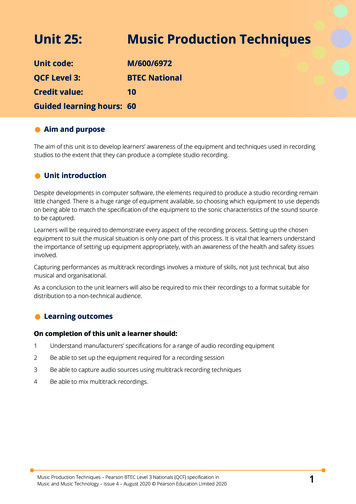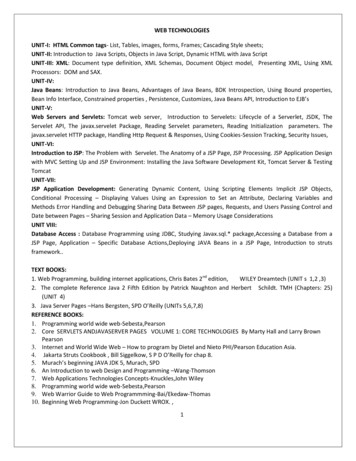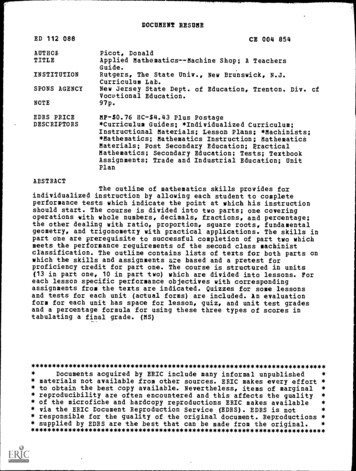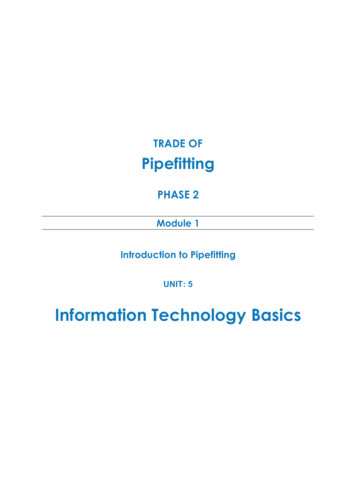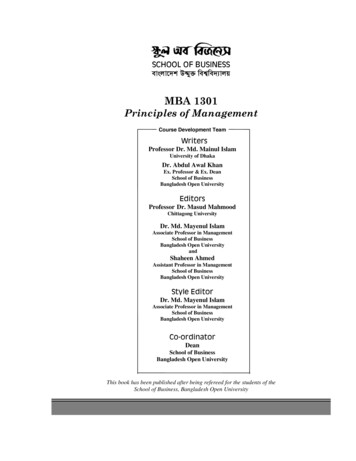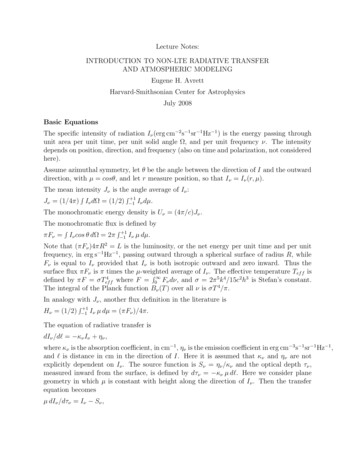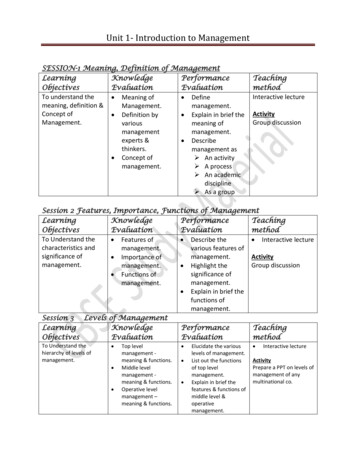
Transcription
Unit 1- Introduction to ManagementSESSION-1 Meaning, Definition of aluationEvaluationTo understand the Meaning of Definemeaning, definition &Management.management.Concept of Definition by Explain in brief theManagement.variousmeaning ofmanagementmanagement.experts & Describethinkers.management as Concept of An activitymanagement. A process An academicdiscipline As a groupTeachingmethodInteractive lectureActivityGroup discussionSession 2 Features, Importance, Functions of ctivesEvaluationEvaluationmethodTo Understand the Features of Describe the Interactive lecturecharacteristics andmanagement.various features ofsignificance ofmanagement.Activity Importance ofmanagement.Group discussionmanagement. Highlight thesignificance of Functions ofmanagement.management. Explain in brief thefunctions ofmanagement.Session 3 Levels of ctivesEvaluationEvaluationmethodTo Understand thehierarchy of levels ofmanagement. Top levelmanagement meaning & functions.Middle levelmanagement meaning & functions.Operative levelmanagement –meaning & functions. Elucidate the variouslevels of management.List out the functionsof top levelmanagement.Explain in brief thefeatures & functions ofmiddle level &operativemanagement. Interactive lectureActivityPrepare a PPT on levels ofmanagement of anymultinational co.
Unit 1- Introduction to ManagementSession 4 Management & esEvaluationEvaluationTo Understand the Meaning of Briefly explain theconcept ofManagement &concept ofManagement &Administration.Management &Administration.Administration. Differencebetween DistinguishManagement &betweenAdministration.Management &Administration.Teachingmethod InteractivelectureActivityPrepare a charthighlighting thedifferences betweenManagement &Administration.
Unit 1- Introduction to ManagementCASE STUDYCompanies come in all kinds. There are some who keep a hawkish eye over its employees,banning even the use of mobile phones in office, and there are others who mandate on somberlysilence and colonial formalities in the office.But at the other end of the spectrum there are establishments, which allow employees to workfrom home and believe in a schedule which is more result-oriented than maintaining a militarydiscipline.These companies with a human face reach out to its employees in the time of crisis, supportingthem and even taking care of the medical expenses of the ailing members in their family.Gone are the days when employees only looked for high paying jobs in a ruthless office set up.Even high-paid employees agree that money does not matter after a certain point, it is jobsatisfaction and a cordial office atmosphere that ultimately makes a difference.At a time when work-related stress is taking a toll on the life of employees, it is refreshing to seesome companies go out of the way to make their staff love the work they do and also ensure theyhave a great work-life balance.In a survey conducted by Great Place to Work Institute and the Economic Lines. Seven hundredcompanies across 20 sectors were surveyed. The responses of 1.8 lakh employees showed thatMNCs were better than Indian companies in terms of best workplaces.Google was adjudged the best company to work for in India.‘Fitness and fun are woven into Google's history’
Unit 1- Introduction to ManagementWhen it comes to facilities, working environment and benefits, work-life balance, very fewcompanies can compete with Google.The company makes sure the employees get the right environment to grow to their true potential.With a creative and colourful ambience, offices are designed to promote fun-filled innovation asthe company believes it is crucial for employees to think creatively and give their best.“The employees have access to the best and brightest IT specialists to help get their jobs done.The TechStop is Google in-house tech support shop, it provides Google employees guidancewith all hardware and software needs and problems at any time,” says a Google spokesperson.Access to best facilities.The employees at Google get to use the company's products to get work done, and beta-testproducts that haven't been released to the public yet.Employees have access to fully equipped gyms across offices in India with trainers andcustomized health programs.Employees can play table tennis, pool, football, air hockey and other games in the recreationarea, or go to one of the several sleep pods for a quick nap.Fun at work “We have numerous special facilities which helps our employees maintain a worklife balance. Every week on Friday, Google hosts TGIF (Thank God It's Friday) after 4p.m. where everyone mingles and works together. This gives an open platform to employees tocollaborate more. Furthermore, Google encourages its employees to pursue their passion, be it inmusic or drama or some other form of art,” says the spokesperson.The company is strongly looking at removing bureaucratic delays and any policies that hinderspeedy decisions.
Unit 1- Introduction to Management“Each year, the company organizes a 'bureaucracy buster' day where employees can suggestchanges to minimize policies and reduce excessive guidelines,” the spokesperson adds.Women’s initiatives Women’s empowerment is another focus area. Google offers academicscholarships to future leaders in technology and supporting employee resource groups likeWomen@Google.FoodFood at Google offices is another attraction. Three meals and unlimited snacks from the cafeteriaare totally free of cost. Meals are made as healthy as possible along with an elaborate menu.For families Involving families, Google hosts its annual 'bring your children to work' day. Onthis day, the company organizes engagement activities for children. Additionally, new employeesat Google can even bring their parents to work on a designated day.[source – www.rediff.com/business]Google is an example of a successful organization among the top MNC’s of India. It has risen tothis level due to its good corporate governance & management policies. A friendly workingenvironment, special healthcare facilities, flexible work hours, work from home options, womenfriendly policies and support among the team members keep employees highly motivated in this1 company.1.1Meaning of ManagementEvery human being has several needs & desires which can be satisfied only by working & livingtogether in organized groups & institutions. In this way the people satisfy their economic &social needs. As a result there are several types of groups e.g. Family, school, government and
Unit 1- Introduction to Managementbusiness firm etc. Such groups achieve their goals by working in controlled & coordinatedmanner.Management involves coordinating and overseeing the most activities of others so that theiractivities are completed effectively & efficiently. The 21 st century economy has becomeknowledge based and is performance driven. It is driven by innovations & technology &organizations have to transform themselves to serve new customer expectations.The manager of today must integrate management skills with new approaches that emphasizethe human touch, enhance flexibility & involves employees. Management is needed in all typesof organization, at all levels of organization, in all organization work areas throughout theworld.Management Manage men t(tactfully)1.2DefinitionsAccording To Harold Koontz "Management is the art of getting things done through others andwith formally organised groups."According to George R. Terry ''Management Is a distinct process consisting of planning,organising, actuating and controlling; utilising in each both science and art, and followed inorder to accomplish pre-determined objectives."According to Massie & Douglas “Management is the process by which co-operative groupdirects actions towards common goals."
Unit 1- Introduction to Management1.3Concept of ManagementThe term management has been interpreted in several ways – 1. Management as an Activity – Management is an activity just like playing, studying,teaching etc. It is an art of getting things done through efforts of other people. Themanagement activities consist ofInterpersonal activitiesDivisional ActivitiesInformative Activities2. Management as a process – Management is considered as process as it comprises ofseries of interrelated functions which lead to achievement of organization goals.Management as a process has following implications. Social Process Integrated Process Continuous Process Interactive ProcessThe elements of Management Process are Planning, Organising, Staffing, Directing andcontrolling.
Unit 1- Introduction to Management3. Management as an academic discipline – Management has emerged as a specializedbranch of knowledge. It comprises principles & practices for effective management oforganization. There are many management institutes imparting education in variousfields of management.4. Management as a group – The term management is frequently used to devote a groupof managerial personnel. All the managers i.e. Chief executive, departmental heads,supervisors are collectively called Management. So, management is concerned with allthose who manage the affairs of an organization.2.1Characteristics of Management1. Management is universal – The principles & techniques of management haveuniversal application. They are not rigid. They can be modified & applied in differentsituations.2. Management is goal oriented – The basic goal of management is to ensureefficiency & economy in the utilization of human, physical & financial resources.Managerial success is measured by the extent to which the objectives are achieved.Thus management is purposeful.3. Management is an intangible force – Management is an unseen force which cannotbe seen but its presence can be felt in the form of results, targets achievedaccording to plans, satisfied employees & orderliness in the organization.4. Management is pervasive – Management is an essential element of every organisedactivity irrespective of the size or type of organization i.e. Government, business,sports, university or hospital. It is also prevalent in all the levels of the organisation,and in all the departments.5. Management is a continuous process – Management functions are continuous &never ending. These functions are simultaneously performed by all managers all thetime i.e. planning, organizing, staffing, directing & controlling.6. Management is a dynamic function – Management is a dynamic function as it has toadopt the changes according to the need of the environment & growth of thebusiness.7. Management is multi-dimensional – It is multidimensional as it involvesmanagement of work, people & operations.
Unit 1- Introduction to Management2.2Importance of ManagementThe efficient management of human & material resources is essential for achievement ofobjectives of any organization. The success of any business lies in the quality of management.The significance of management will be more clear through the following points :1. Determination of objectives – Management helps in determining the objective of theorganization. No organization can succeed in its operations unless its objectives areidentified & well defined. These objectives have to be communicated to all the peopleworking in the organization.2. Achievement of the objectives – Management plays a vital role in accomplishment oforganizational objectives & goals. The coordination & integration of material & humanresources helps in achieving the pre-determined goals effectively & efficiently.3. Efficient use of resources – An efficient management can lead a business towardsgrowth & prosperity. Management reduces wastage of human, material & financialresources through proper planning & control.4. Encourages innovation – Management encourage innovation in the organization.Innovation brings new ideas, new methods, new products & makes the organizationmore competitive.5. Personal objectives – Personal objectives are concerned with satisfaction of financial &social needs of the employees. Through motivation & direction management helps theindividuals to achieve their personal goals while working towards organizationalobjectives.6. Economic development – Management helps in development of the society byproducing good quality products, creating employment opportunities & adopting newtechnology.7. Creates dynamic organization – Management helps the employees to overcome theirresistance to change & adopt as per changing situation to ensure its survival & growth.2.3Functions of ManagementAccording to functions approach managers perform certain activities to effectively & efficientlycoordinate the work of others. They are classified as –1. Planning – It involves defining jobs, establishing strategies for achieving those goals &developing plans to integrate & coordinate activities.
Unit 1- Introduction to Management2. Organising – Involves arranging & structuring work to accomplish the organizationgoals.3. Staffing – Involves manning the organization structure through proper & effectiveselection.4. Directing – Involves influencing, guiding supervising & motivating the subordinate.5. Controlling – Involves monitoring, comparing & correcting work performance.3.1Levels of Management
Unit 1- Introduction to ManagementIn any organization all those who are responsible for the work of others are known asmanagers. Though their primary task remains the same – getting the things done by others.Wide variance exist with regard to authority & responsibility of managers. These differences arelargely due to the differences in the levels of management. We normally visualize a company’smanagement as a pyramid.3.2Top level Management
Unit 1- Introduction to ManagementTop management constitute the highest level in the management hierarchy. This level consistsof small group of executives who are the senior most in the organization. Top management hasthe maximum source of authority & it establishes goals & policies for the enterprise.Top Management consist of1.2.3.4.5.6.7.8.CEO (Chief Executive Officer)COO (Chief Operating Officer)BOD (Board of Directors)CFO (Chief Finance Officer)ChairmanPresidentVice PresidentM.D. (Managing Director)Functions of Top Management1.2.3.4.5.6.7.3.3To lay down the objectives of the enterprise.To prepare strategic plans & policies for the enterprise.To assign jobs to different individuals working at middle level.To arrange all the finance required to carry on day to day activities.Top level management is responsible for the survival & growth of the organization.It makes liaison with the outside world like government, suppliers, media, public etc.It reviews the performance and controls the activities of all departments.Middle level ManagementMiddle level constitutes the execution level of the organization i.e. the departmental heads.They are responsible to the top management for the efficient function of their department &for executing the plans & policies made by top level.Middle level consists of heads of the various departments. Purchase ManagerFinance ManagerHuman ResourceExecutive OfficerPlant SuperintendentFunctions of Middle Level Management1. They act as a linking pin between the top & lower level management.2. They organize all the resources & activities of their department.
Unit 1- Introduction to Management3. They execute & implement the plans of the organization in accordance with the policiesof the top management.4. They select, appoint & train employees of their department.5. They evaluate the performance of their subordinates & prepare performance appraisalreports.6. They offer various incentives to employees so that they perform to best of their ability &ensure higher productivity.3.4Lower Level ement/Operational Management/First-time Management.asSupervisoryIt refers to the lowest level in the hierarchy of the organization. It is directly concernedwith the control over the performance of the operative employees. They devote moretime on the supervision of workers. Their authority & responsibility is limited.It consist of Foreman Supervisors Sub-department Executives ClerksFunctions of Lower Level Management 4.1To represent the problems or grievances of workers before the middle levelmanagement.To plan & organize the activities of their unit.To provide training to workers.To maintain good working conditions & developing healthy relations betweensuperior & subordinate.To communicate with workers, listen to their suggestions & motivate them totake initiative.To maintain discipline among the work force.To maintain standard of quality, ensure steady flow of output & minimizewastage.Management & Administration
Unit 1- Introduction to ManagementManagement is the key function in any organization “It is the function of working with people &coordinating their efforts so as to accomplish the objectives of the organization”. Everyinstitution requires making of decisions, handling people, evaluating their performance &achieve the objectives.According to Newman “Administration means guidance, leadership & control of the efforts ofthe groups towards some common goal”. Administration lays down the fundamentalframework of an organization, within which the management of the organization functions.Administration is concerned with laying down of policies, determining goals and management isconcerned with implementation of the policies for achievement of goals. Every manager spendsa part of his time in performing administration function & remaining in management function.As shown in the figure above Top level management devotes more time to administrationfunction & less time to managerial function. But as we more down the hierarchy lower functionmanagers spend more time in implementation of policies (i.e. management) rather thanframing the policies & procedures (i.e. administration).Top Level ManagementManagementAdministrationMid Level ManagementLower Level Management4.2BASISDifference between Management and AdministrationMANAGEMENTADMINISTRATION
Unit 1- Introduction to cessInfluenceFunction4.3Management means getting the Administration is concerned with thework done through & with others formulation of objectives, plans, policiesof the organization.Management is relevant at Middle Administration is relevant at top level& Lower Level or ManagementManagement.It is an executing functionIt is a decision making functionTechnical & Human SkillsConceptual & Human skillsIt is applicable to business It is applicable to non business concernsconcerns i.e. profit making i.e. clubs, schools, hospitals etc.organization.Management decides who should Administration decides what is to bedo it and how it is to be done.done & when it is to be done.The decisions are influenced by The decisions are influenced by publicopinions, values, beliefs of opinion, government policies, custommanagers.etc.Management is a doing function Administration is a thinking functionsbecause manager get work done because plans & policies aretheir subordinates.determined under it.ConclusionTheoretically both the terms are different but when put into practice the terms can be usedinterchangeably as all the levels of management are performing both administrative &functional activities.Summary1.Management : "Management is the art of getting things done through others and withformally organised groups."2.Concept of Management :Management can be understood as -As an Activity, Process, Academic Discipline and as a Group3.Characteristic of Management : Features of Management are Universal, Goal Oriented, Intangible Force, Pervasive, Continuous Process, Dynamic andMulti-Dimensional
Unit 1- Introduction to Management4.Importance of Management : Management helps in Determination of Objectives, Achievement of the Objectives, Efficient use of resources,Encourages innovation, Personal Objectives, Economic Development, Creates DynamicOrganization5.Functions of Management : Management functions comprises of Planning, Organizing, Staffing, Directing and Controlling6. Levels of Management : Management consists of 3 levels i.e. 1) Top Level – Maximum authority, establish goals for the enterprise2) Middle Level – Responsible for efficient functioning of different departments3) Lower Level – Direct control over performance of operative employees7. Management is doing function and Administration is a thinking function.Key ationSupervisionMotivationSELF TEST QUESTIONS1. Choose the Correct Answer1) Management is the thers.
Unit 1- Introduction to Management2) Management is considered as . as it comprises of series of inter relatedfunctions which lead to achievement of organization goals. (Activity/Process/Discipline)3) Management is an . force. (Tangible/Intangible/Universal)4) . involves arranging and structuring work to accomplish the organization goals.(Planning/Organising/Staffing)5) . Level of Management is directly concern with the control over theperformance of the operative employees. (Top/Middle/Lower)2.Fill in the blanks1. The Principles and Techniques of Management are . applicable.2. . involves manning the organization structure through proper and effectiveselection.3. . Involves monitoring, Comparing and correcting work performance.4. Middle level constitutes the . level of the organization.5. . is concerned with the formulation of objectives, plans and policies of theorganization.3.Match the following1. Personal Objective2. Planning3. Directing4. Innovation5. Administration1. Involves defining jobs, establishing strategies2. Creating new ideas, new methods, new products to makethe organization more competitive3. Framing policies and procedures4. Through motivation and direction, Management helps theindividuals to achieve their personal goals while workingtowards organizational objectives5. Involves influencing, guiding, supervising and motivating thesubordinates4.True or False1.Management functions are continuous and never ending.2.Management does not help in development of the society.3.Controlling involves motivating the subordinates.4.Management ensures efficiency and economy in the utilisation of human, physical andfinancial resources.5.Administration is applicable to business concern only.5.Answer the following briefly
Unit 1- Introduction to Management1) Identify and explain the basic characteristic of Management involved in the statement – “The2)3)4)5)6)Activities involved in managing and organization are common to all organizations whethereconomic, social or political”.“Lack of proper management result in the wastage of time, money and efforts” in the light ofthis statement explain the importance of management.Raman is working as “Plant Superintendent” in ABC Ltd. Name the managerial level at which heis working. State any four functions he will perform as “Plant Superintendent” in this company.Rajat is working as “Regional Manager” in XYZ Ltd. Name the managerial level at which he isworking. State any four functions he will perform as “Regional Manager” in this company.How has the meaning of management evolved over time?Differentiate between management and administration on the basis of skills, influence and levelof management.6.Answer in Detail1.Briefly explain any five features of Management.2.“Management is a series of continuous inter related functions with no pre-determinedsequence.” Explain.
According To Harold Koontz "Management is the art of getting things done through others and with formally organised groups." According to George R. Terry ''Management Is a distinct process consist



